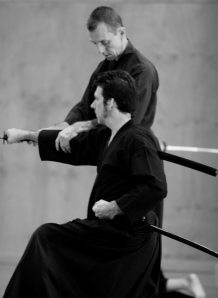
One of the most visually spectacular elements of the 2012 Australian Martial Arts Festival, and the 8th Australian National Gumdo Championships, was the bamboo and mat cutting performances. The mats are soaked in water for at least 24 hours to make them solid. Cutting bamboo is a grading requirement.
I have tried mat cutting a few times, and occasionally have experienced the thrill of the clean, almost magical and effortless cut through the wet mat. Unfortunately, more often the sword wedges itself in the mat, or bounces off the mat or fragments the mat into portions – such that the mat looks like it’s been attacked by a giant, ferocious (and very untidy) rat. So, I can scarcely begin to imagine the degree of training and skill required to slice through several stands of bamboo or multiple numbers of mats at one time. However, this was achieved over the nationals week-end, and very spectacularly – so awe-inspiring.




He is finishing the cutting of the seven bamboo stands with a return cut

If you look where her free hand is positioned, you can see the cut she achieved in the bamboo with this back cut: the bamboo is just beginning to separate from the cut



Even reviewing these photos now for this post, gives me goose-bumps. The level of dedicated training and the concentration to achieve results like this leaves me breathless.






















